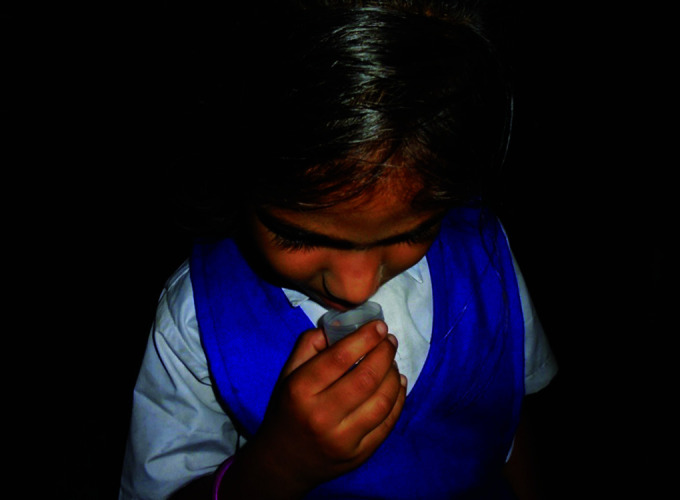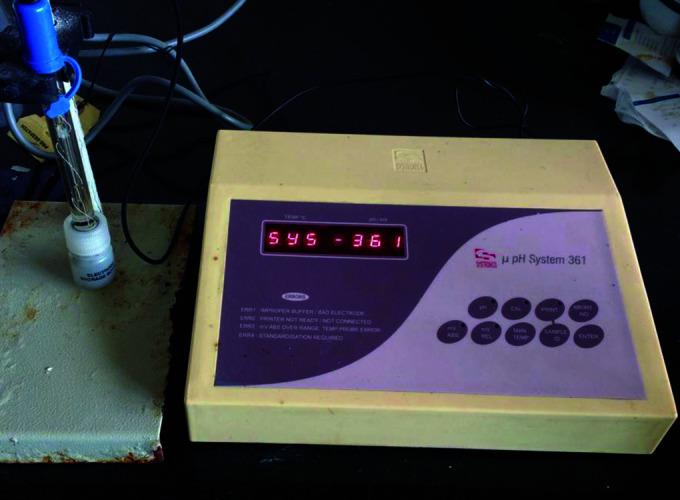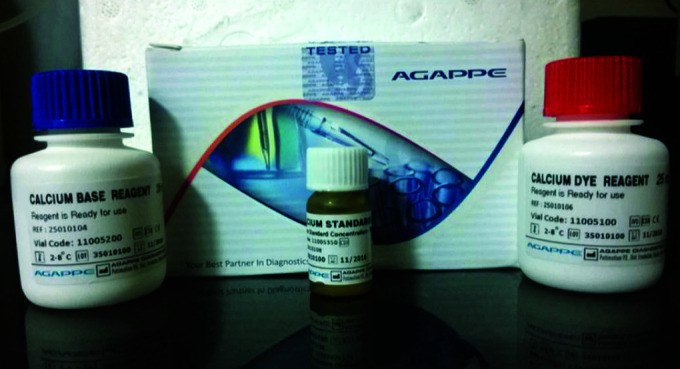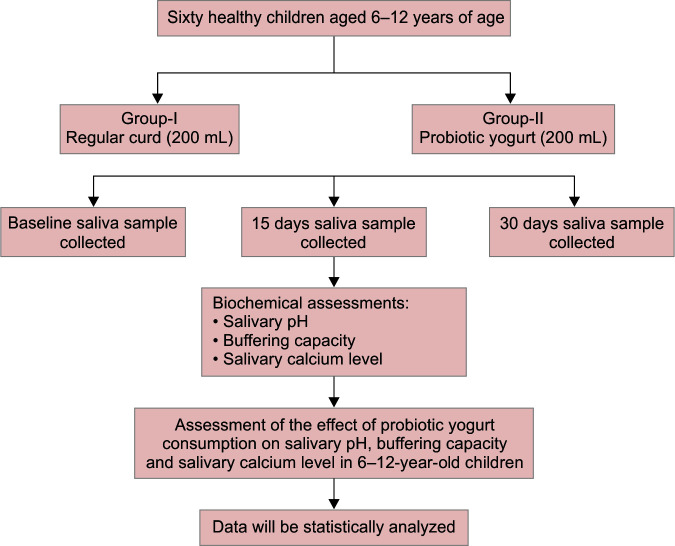Abstract
Introduction
Dental caries is a preventable disease that can be prevented by suppressing any one of the factors of the Keyes triad.
Aim and objective
To investigate the effect of probiotic yogurt on salivary pH, calcium level, and buffering capacity.
Materials and methods
A total of 60 children were randomly selected and were divided into 2 groups. The test group consumed 200 mL of probiotic yogurt and the control group consumed 200 mL of regular curd everyday for 30 days. A base-line nonstimulated salivary sample (2 mL) was collected. The salivary pH, buffering capacity, and calcium level was assessed at baseline, after 15 and 30 days. The data were statistically analyzed.
Result
The mean pH levels of the probiotic group were 7.03 and salivary buffering capacity was found to be 2.000. Salivary calcium levels increased with the use of probiotic yogurt at the end of 30 days (mean of 4.79) compared to the control group.
Conclusion
Consumption of probiotic yogurt for a short period of time can prevent dental caries by increasing salivary calcium level.
How to cite this article
Malavalli PL, Shetty SB, Thimmaiah C, et al. Evaluation of the Effect of Probiotic Yogurt Consumption on Salivary pH, Buffering Capacity and Calcium Level in 6-12-year-old Children: An In Vivo Study. Int J Clin Pediatr Dent 2022;15(2):194-198.
Keywords: Buffering capacity, Probiotic, Salivary calcium, Salivary pH
Introduction
Dental caries is considered as a multifactorial disease and common disease of childhood. Numerous oral bacterial species are the active pathogens concerned with the progression of dental caries such as mutans streptococci, Streptococcus sobrinus and Lactobacillus acidophilus species. Dental caries can be prevented by decreasing the number of cariogenic flora within the oral cavity.
Numerous noninvasive strategies are being used to prevent dental caries formation. The noninvasive treatment of initial lesions by remineralization has the potential to be a significant advance in the clinical management of caries.1
The use of milk and milk products, having a protective effect against the development of dental caries, has been a unique concept in remineralization.2 Another approach to bacterially-mediated diseases has been the use of probiotics.
The word “probiotic” comes from Greek, and it means “for life.” Most probably, it was Ferdinand Vergin who invented the term “probiotic” in 1954.3 Probiotics can be defined as “Live microorganisms that when administered in adequate amounts confer a health benefit on the host” (FAO/WHO 2001). The thought was that the harmless bacteria in the fermented products competed with pathogens injurious to health.4 Most probiotics are Gram-positive bacteria that belong to the genera Lactobacillus or Bifidobacterium.5,6
The calcium concentration of saliva and dental plaque is an important index accounting for the balance between stages of demineralized and remineralized enamel.7 Studies have shown that consumption of milk and yogurt can reduce the risk of dental caries through high level of calcium concentrations.8
A variety of microorganism strains are studied for their probiotic properties. The most used species belong to the genera Lactobacillus and Bifidobacteria.9 A large range of commercially available products of probiotics containing numerous microorganism strains are available such as sucking tablets, chewing gums, lozenges and dairy products such as milk, ice cream, cheese, yoghurt, etc.10 The classic food containing probiotic is yogurt (curd) and consumption of dairy products on a daily basis seems to be the most natural and effective way to ingest probiotic bacteria. Dairy yogurt is prepared using a culture of Lactobacillus bulgaricus, Streptococcus salivarius, and Streptococcus thermophilus bacteria. In addition, L. acidophilus, Lactobacillus bifidus, and Lactobacillus casei are also utilized in yogurt culturing.
Hence, the aim of this present study was to evaluate the effect of consumption of probiotic yogurt on salivary pH, buffering capacity, and salivary calcium level.
Materials and Methods
Ethical clearance was obtained from the ethics committee AJ Institute of Medical Sciences and Research Centre, Mangaluru before the start of the study (Ref no. AJEC/REV/D/14/2015-16). The nature and design of the study were explained in detail to the teacher, parent, and child and informed consent was obtained for the same.
Inclusion Criteria
Study subjects for whom informed consent from parents and assent is obtained.
Systemically healthy subjects.
Caries free children (DMFT = 0)
Exclusion Criteria
Study subjects for whom informed consent from parents and assent is not obtained.
Children with decayed teeth.
Children with a history of taking any antibiotic treatment throughout the study.
Children on any other supplements containing probiotics during the study.
Children on use of xylitol products for 3 weeks before and throughout the study.
Medically compromised children.
Method
A total of 60 healthy caries-free school children between the age group of 6-12 years from a school of Mangaluru city were randomly divided into 2 groups based on the yogurt prescribed:
Regular curd (group A) as a control group
Probiotic yogurt (group B) as a test group (Flowchart 1)
Flowchart 1.
Investigation design
Generation of the random sequence was done using a table generated from the computer of random numbers by an independent investigator and sequential allocation was done by the investigator.
A base-line nonstimulated whole salivary sample (2 mL) was collected in the morning by asking the patient to drool passively into a sterile test tube for 5 minutes (Fig. 1). The children were informed not to eat or drink (except water) 1 hour before saliva collection in order to reduce possible food debris and saliva stimulation. The samples collected in sterile test tubes were carried in the icebox containing ice (used as transport media). The pH of saliva, buffering capacity, and calcium level in saliva was assessed. The children were advised to consume 200 mL of regular curd (control group) and 200 mL of probiotic yogurt (test group) each day for 30 days under the supervision of two investigators. Saliva sample was taken on the 15th day and at the end of 30 days using the same procedure and the pH of saliva, buffering capacity, and calcium level were assessed.
Fig. 1.

Collection of saliva samples
Estimation of Salivary pH and Buffering Capacity
A manual pH meter was used to measure the salivary pH and the buffering capacity was measured by the Erricson method (1959) where 0.5 mL of saliva was mixed with 1.5 mL of 5 mmol/L HCl. The mixture was shaken vigorously, subjected to centrifugation for a minute, and allowed to stand for 10 minutes and the final pH was measured using a manual pH meter (Fig. 2).
Fig. 2.

Manual pH meter
Estimation of Salivary Calcium Level
Autoanalyzer which works on the principle of atomic absorption spectrophotometer was used to estimate the calcium level. Human diagnostic kit was used for estimation (Fig. 3). The data collected was then analyzed statistically using SPSS software 20.
Fig. 3.

Calcium kit
Results
The salivary pH in the test group (probiotic yogurt) remained constant throughout the study period (mean of 7.032). Whereas the control group (normal curd) showed slight reduction in pH at the end of 30 days (mean of 6.548). At the end of 30 days of consumption, the salivary pH was evaluated between the two groups, in the test group the mean pH value was higher when compared to the control group and this difference was significant statistically (p = 0.05) (Table 1).
Table 1.
Comparison of test and control group with respect to salivary pH levels at baseline, 15th day, and 30 days of consumption
| Salivary pH levels | Minimum | Maximum | Mean | Std. Deviation | |
|---|---|---|---|---|---|
| Probiotic | Baseline | 5.0 | 8.0 | 7.032 | 0.9123 |
| 15 days | 5.0 | 8.0 | 7.032 | 0.9123 | |
| 30 days | 5.0 | 8.0 | 7.032 | 0.9123 | |
| Normal | Baseline | 5.0 | 8.0 | 6.581 | 1.0255 |
| 15 days | 5.0 | 8.0 | 6.968 | 0.9826 | |
| 30 days | 5.0 | 8.0 | 6.548 | 0.9605 | |
The salivary calcium level in the test group showed a significant increase from baseline to the 30th day (mean of 4.793). There was only a slight increase of the calcium level in saliva in the control group, but it was not statistically significant (mean of 1.53). After 30 days of consumption, the mean calcium level of saliva in the test group was higher compared to the calcium level in the control group and the difference was significant statistically (p = 0.001). There was a statistically significant increase in salivary calcium level from baseline to 30th day in the test group (p = 0.006), whereas, in the control group there was no statistically significant difference (p = 0.662) (Tables 2 and 3).
Table 2.
Comparison of test and control group with respect to salivary calcium levels at baseline, 15th day, and 30 days of consumption
| Calcium levels | Minimum | Maximum | Mean | Std. Deviation | |
|---|---|---|---|---|---|
| Probiotic | Baseline | 1.504 | 6.001 | 2.87 | 1.12 |
| 15 days | 1.150 | 7.561 | 3.46 | 1.07 | |
| 30 days | 2.251 | 10.690 | 4.793 | 3.04 | |
| Normal | Baseline | 1.018 | 4.224 | 2.55 | 0.85 |
| 15 days | 1.160 | 5.005 | 2.69 | 1.19 | |
| 30 days | 1.274 | 5.641 | 2.84 | 1.53 | |
Table 3.
Intra-group comparison of salivary calcium level
| Repeated measures ANOVA | ||
|---|---|---|
| Calcium levels | F value | p value |
| Probiotic group | 7.21 | 0.006* |
| Normal group | 0.36 | 0.662 |
The salivary buffering capacity in both the groups remained constant throughout the study period. There was no statistical difference in buffering capacity at the end of 30 days (Table 4).
Table 4.
Comparison of salivary buffering capacity at baseline, 15 days, and 30 days
| Buffering capacity | Minimum | Maximum | Mean | Std. Deviation | |
|---|---|---|---|---|---|
| Probiotic | Baseline | 2.0 | 2.0 | 2.000 | 0.0000 |
| 15 days | 2.0 | 2.0 | 2.000 | 0.0000 | |
| 30 days | 2.0 | 2.0 | 2.000 | 0.0000 | |
| Normal | Baseline | 2.0 | 2.0 | 2.000 | 0.0000 |
| 15 days | 2.0 | 2.0 | 2.000 | 0.0000 | |
| 30 days | 2.0 | 2.0 | 2.000 | 0.0000 | |
Discussion
The oral cavity contains different bacteria that may be resistant to antibacterial agents. Many of these oral species are resistant bacteria and most of these harmless bacteria have been changed into potential pathogens. These bacteria in the oral cavity are either planktonic or integrated into an oral biofilm of diverse oral surfaces or niches.11 It is essential to have a thorough understanding of the oral microbiota and its functions in oral health and disease in order to develop probiotic or prebiotic interventions for applications in oral health care and to know their mechanisms of action and potential risks.12 The mechanism of action of probiotics is thought to combine local and systemic events including adhesion, coaggregation, growth inhibition, bacteriocin production, and immunomodulation. Thus, probiotics may have preventive and therapeutic effects.12 Hence, probiotics can be considered as the best supplement to prevent dental caries. To compete with the different bacteria in the oral cavity, the probiotics for oral health must contain different kinds of bacteria. Great importance is being given to the use of a probiotic therapy for the treatment of dental caries, periodontal diseases, and oral malodor.6
Probiotics have been studied extensively for many years for their health-promoting effects. Probiotics are microorganisms proven to exert health-improving benefits in humans and animals. In the past decade, probiotics have been investigated from the oral health perspective. Probiotic technology provides a breakthrough approach to maintain oral health by using the natural beneficial bacteria commonly found in the mouth to provide a natural defense against those bacteria that are thought to be harmful to teeth and gums.13
Microorganisms commonly used as probiotics are L. acidophilus, L. casei, Lactiplantibacillus plantarum, Lactobacillus gasseri, Lactobacillus delbreukii sp., Pediococcus pentosaceus, Saccharomyces cerevisiae, Bifidobacterium bifidum, Bifidobacterium lactis, Enterococcus faecium, Bacillus subtilis, Bacillus cereus, Aspergillus oryzae, etc.3
Recent studies suggest that probiotics can exert beneficial effects on the host through distinct molecular and cellular pathways. Evaluation of a suitable vehicle for probiotic administration is essential. Most of the naturally occurring probiotics are found in fermented dairy products.14 Curd or yogurt is considered to be the common constituent of the Indian diet and also it is readily available.
In the present study, the salivary pH was significantly elevated in the probiotic yogurt group when compared to the normal curd group which is similar to the results of a study conducted by Srivastava et al., which also showed significant increase in salivary pH from baseline to 7 days with probiotic yogurt, as compared to normal curd.10
Normal curd is usually acidic in nature and this could be the reason for the decrease in salivary pH in the children who consumed normal curd. Despite of this reduction, the salivary pH levels were still above the critical salivary pH (5.2-5.5), which is considered harmful for the initiation of dental caries. This suggests that curd even though is acidic in nature, it does not pose any risk for dental caries. On the contrary, it may prove beneficial because of its calcium, phosphorous, protein, and vitamin content.4 However, probiotic yogurt consumption lead in an elevation in the pH of saliva (p < 0.05), thus manifesting it to be more advantageous than normal curd.
Depending on the pH of the saliva, calcium is distributed in saliva as ionized and bound form. The free, ionized calcium is very important when it comes to caries attack, as this is the fraction of calcium that takes part in establishing the equilibrium between calcium phosphates of dental hard tissue. There is a strong correlation between both total and ionized calcium in saliva and dental plaque showing a flow of calcium over the plaque interface following existing diffusion gradients in ionized calcium. The balance between demineralization and remineralization depends on the salivary calcium and phosphate concentration as well as the level of the salivary alkaline phosphatase.15
Consumption of high-calcium dairy products can be an effective method in decreasing dental enamel demineralization by increasing the calcium content of dental plaque.7
Poureslami et al. demonstrated probiotic yogurt yielded a higher level of significant increase in salivary calcium when compared to plain yogurt (p < 0.01).7 Higher levels of salivary calcium increase the remineralization potency of the plaque.
Salivary buffers can reverse the low pH in plaque and allow for oral clearance thus preventing demineralization of enamel. Hence, in the present study, the buffering capacity of saliva was assessed at baseline, 15 days, and 30th day of consumption of probiotic yogurt and normal curd.
Salivary buffer capacity in both the groups was not changed in the current study. This was in accordance with a study conducted by Ahola et al. which showed no significant changes in buffering capacity between the study groups on short term consumption probiotic cheese.16
Conclusion
Consumption of probiotic yogurt for a short period of time showed marked elevation in salivary pH and also elevated level of salivary calcium content was noted, which helps in preventing dental caries by reminerization of demineralized enamel. However further researches are to be carried out in the field of dentistry to prove the efficiency of the same.
Orcid
Priya Meharwade https://orcid.org/0000-0003-2328-1936
Footnotes
Source of support: Nil
Conflict of interest: None
References
- 1.Clarkson JJ, McLoughlin J. Role of fluoride in oral health promotion. Int Dent J. 2000;50(3):119–128. doi: 10.1111/j.1875-595x.2000.tb00552.x. [DOI] [PubMed] [Google Scholar]
- 2.Thimmaiah C, Shetty P, Shetty SB, et al. Comparative analysis of the remineralization potential of CPP-ACP with fluoride, tri-calcium phosphate and nanohydroxyapatite using SEM/EDX - an in vitro study. J Clin Exp Dent. 2019;11(12):e1120–e1126. doi: 10.4317/jced.55941. [DOI] [PMC free article] [PubMed] [Google Scholar]
- 3.Markowiak P, Śliżewska K. Effects of probiotics, prebiotics, and synbiotics on human health. Nutrients. 2017;9(9):1021. doi: 10.3390/nu9091021. [DOI] [PMC free article] [PubMed] [Google Scholar]
- 4.Sudhir R, Praveen P, Anantharaj A, et al. Assessment of the effect of probiotic curd consumption on salivary pH and streptococcus mutans counts. Niger Med J. 2012;53(3):135–139. doi: 10.4103/0300-1652.104382. [DOI] [PMC free article] [PubMed] [Google Scholar]
- 5.Wasfi R, Abd El-Rahman OA, Zafer MM, et al. Probiotic Lactobacillus sp. inhibit growth, biofilm formation and gene expression of caries-inducing Streptococcus mutans. J Cell Mol Med. 2018;22(3):1972–1983. doi: 10.1111/jcmm.13496. [DOI] [PMC free article] [PubMed] [Google Scholar]
- 6.Vuotto C, Longo F, Donelli G. Probiotics to counteract biofilm-associated infections: promising and conflicting data. Int J Oral Sci. 2014;6(4):189–194. doi: 10.1038/ijos.2014.52. [DOI] [PMC free article] [PubMed] [Google Scholar]
- 7.Poureslami H, Pishbin L, Eslaminejad Z, et al. The effects of a dairy probiotic product, espar, on salivary calcium and mutans streptococci. J Dent Res Dent Clin Dent Prospects. 2013;7(3):147–151. doi: 10.5681/joddd.2013.023. [DOI] [PMC free article] [PubMed] [Google Scholar]
- 8.Moynihan PJ, Ferrier S, Jenkins GN. The cariostatic potential of cheese: cooked cheese-containing meals increase plaque calcium concentration. Br Dent J. 1999;187(12):664–667. doi: 10.1038/sj.bdj.4800362. [DOI] [PubMed] [Google Scholar]
- 9.Chinnappa A, Konde H, Konde S, et al. Probiotics for future caries control: a short-term clinical study. Indian J Dent Res. 2013;24(5):547–549. doi: 10.4103/0970-9290.123363. [DOI] [PubMed] [Google Scholar]
- 10.Srivastava S, Saha S, Kumari M, et al. Effect of probiotic curd on salivary pH and Streptococcus mutans: a double blind parallel randomized controlled trial. J Clin Diagn Res. 2016;10(2):ZC13–ZC16. doi: 10.7860/JCDR/2016/15530.7178. [DOI] [PMC free article] [PubMed] [Google Scholar]
- 11.Mahasneh SA, Mahasneh AM. Probiotics: a promising role in dental health. Dent J (Basel) 2017;5(4):26. doi: 10.3390/dj5040026. [DOI] [PMC free article] [PubMed] [Google Scholar]
- 12.Devine DA, Marsh PD. Prospects for the development of probiotics and prebiotics for oral applications. J Oral Microbiol. 2009;1 doi: 10.3402/jom.v1i0.1949. [DOI] [PMC free article] [PubMed] [Google Scholar]
- 13.Bhalla M, Ingle NA, Kaur N, et al. Mutans streptococci estimation in saliva before and after consumption of probiotic curd among school children. J Int Soc Prev Community Dent. 2015;5(1):31–34. doi: 10.4103/2231-0762.151970. [DOI] [PMC free article] [PubMed] [Google Scholar]
- 14.Jindal G, Pandey RK, Singh RK, et al. Can early exposure to probiotics in children prevent dental caries? A current perspective. J Oral Biol Craniofac Res. 2012;2(2):110–115. doi: 10.1016/j.jobcr.2012.05.001. [DOI] [PMC free article] [PubMed] [Google Scholar]
- 15.Shahrabi M, Nikfarjam J, Alikhani A, et al. A comparison of salivary calcium, phosphate, and alkaline phosphatase in children with severe, moderate caries, and caries free in Tehran's kindergartens. J Indian Soc Pedod Prev Dent. 2008;26(2):74–77. doi: 10.4103/0970-4388.41621. [DOI] [PubMed] [Google Scholar]
- 16.Ahola AJ, Yli-Knuuttila H, Suomalainen T, et al. Short-term consumption of probiotic-containing cheese and its effect on dental caries risk factors. Arch Oral Biol. 2002;47(11):799–804. doi: 10.1016/s0003-9969(02)00112-7. [DOI] [PubMed] [Google Scholar]



